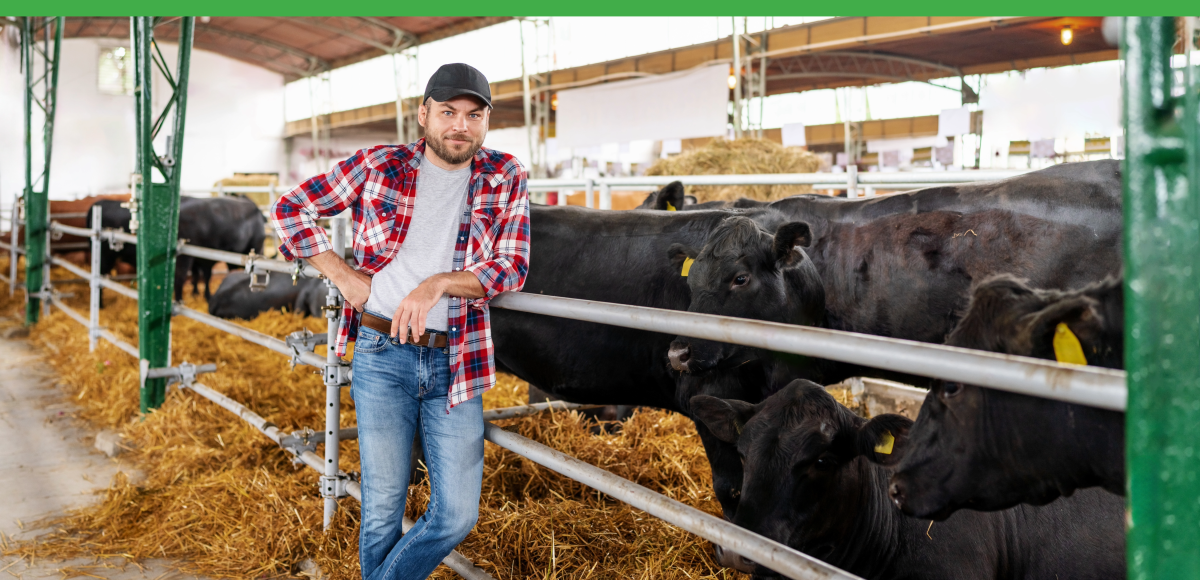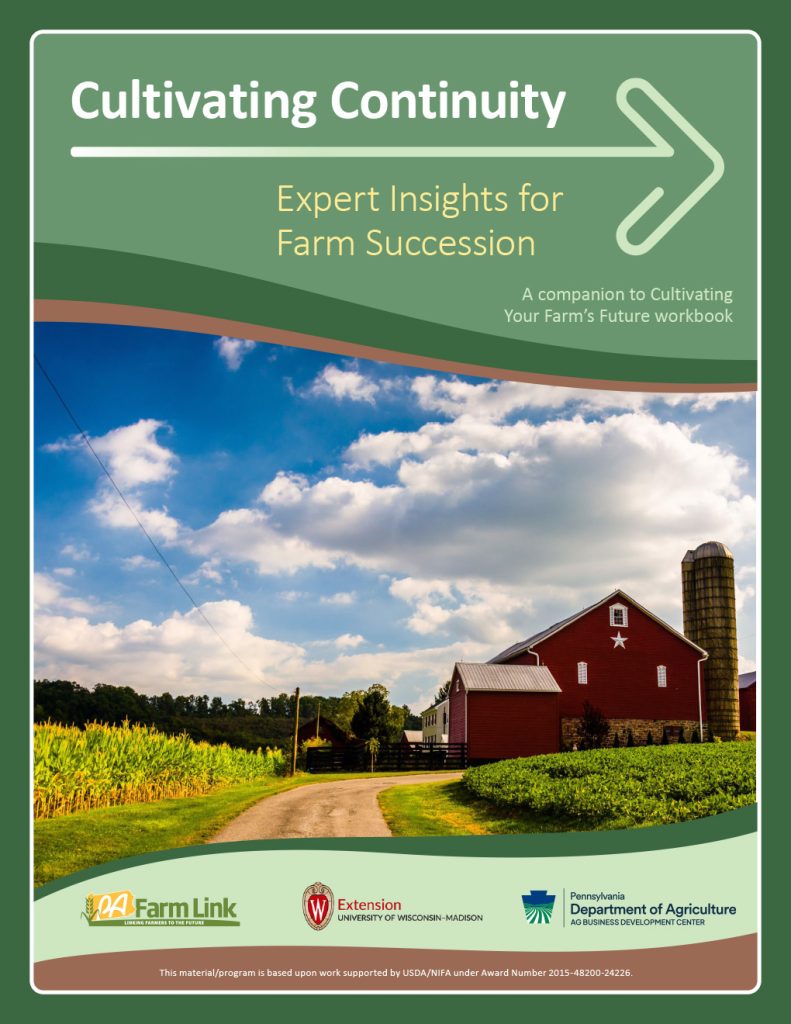
Introduction
Young farmers are often familiar with the old adage: if they want to own a farm, they must inherit it or marry it. However, farm succession planners know there’s a third, perhaps equally challenging, strategy: co-ownership. If you want to become a farm owner but aren’t sure you can afford to do it on your own, co-ownership could be a solution. In fact, farm succession plans often include stages of co-ownership of the farm. Co-ownership can help lessen the financial and managerial challenges of transitioning an operation all at once. Keep in mind that having a business partner may be just another type of marriage. Here’s how co-ownership works, along with risks and benefits to consider.
What can be co-owned?
Multiple owners may divide ownership of individual assets such as land, equipment, or livestock. Alternatively, if a farm is structured as a legal entity such as a limited liability company (LLC) or corporation, the entity may own some or all of the farm assets, and the owners instead simply share ownership of the entity.
How does co-ownership happen?
Co-ownership can be a conscious choice. A transition or sale may be structured in stages, requiring the current owners and the future owners to work together as the farm transitions. Other individuals may choose to become business partners, purchasing and operating a farm together. Still other farmers may work with a ‘silent’ partner—one who invests as an owner but does not assist with day-to-day management.
Alternatively, co-ownership may also occur involuntarily. Perhaps a creditor takes ownership of one individual’s assets as payment. Maybe an heir or beneficiary receives partial ownership alongside another heir or beneficiary. Involuntary co-ownership can also occur when an individual fails to make an estate plan and their assets are distributed in equal shares to multiple heirs based on state law. Passing partial ownership through an estate plan or gift may be a conscious choice by the giver, but it may not necessarily be what the heirs or beneficiaries may have chosen if given the opportunity to weigh in.
What are the risks and requirements of co-owning a farm?
Whether co-ownership is a conscious decision or is forced upon individuals, many of the underlying rights and obligations remain the same. Some of the rights and risks of co-ownership are fiduciary duties. Co-owners owe one another fiduciary duties of loyalty, care, good faith, and fair dealing. These duties generally mean that each will manage the company and its assets to perform in the best interests of the company. No co-owner is to use the company’s property for their own purposes, take advantage of a company opportunity for one’s own benefit (unless it is also in the company’s best interests), compete with the company, engage in a transaction where the co-owner has a conflict of interest, take an action that is not in the company’s best interests, or engage with the company in bad faith or unfairly, among other things. In short, the co-owners are to make decisions for the company that are in the company’s best interests. However, co-owners may disagree about what actions are best for the company. While a majority vote may decide the direction of the company, a minority owner may still have a right to challenge the action as being against the company’s best interests (i.e., that the other owner(s) violated a fiduciary duty).
The owners may waive some fiduciary obligations by written agreement. These agreements are known by a number of names, such as tenancy-in-common agreement, partnership agreement, operating agreement, or bylaws. Potential co-owners should carefully consider the rights of other co-owners in managing the business, including fiduciary duties, as well as the risks and benefits of waiving those fiduciary duties.
Another right and risk of co-ownership relates to the characteristics of the type of co-ownership. While a farm or its assets may be owned in a legal entity, they may also be co-owned outright as either a joint tenancy or a tenancy-in-common.
A joint tenancy is when two or more co-owners have an equal interest in the property, regardless of unequal contributions at its creation.[1] In Wisconsin, a joint tenancy is assumed to include rights of survivorship, unless otherwise stated. Therefore, upon the death of a joint tenant, the other joint tenants succeed to that decedent’s interest. For example, if Bill and Judy are joint tenants in a 40-acre field, then upon Bill’s death, Judy becomes the owner of the entire field, regardless of what Bill’s will may say or what his heirs may desire. If Bill, Judy, and Robert are joint tenants of a different 40-acre field, then upon Bill’s death, Judy and Robert become joint owners of the entire field, receiving Bill’s portion and splitting it between them.
A tenancy-in-common has a different result. A tenancy-in-common is a different type of co-ownership. In a tenancy-in-common, the co-owners are presumed to own equal undivided interests in the property but may specify a different ownership split (i.e., 60-40, 75-25, etc.). Regardless of the split, the co-owners in a tenancy-in-common do not have rights of survivorship. For example, if we review the ownership of Bill and Judy’s 40-acre field and find it is a tenancy-in-common, then upon Bill’s death, the property passes pursuant to Bill’s estate plan or intestacy distribution rules. Judy does not automatically receive Bill’s ownership.
A joint tenancy may be unilaterally broken and transformed into a tenancy-in-common, typically as simply as recording a quit claim deed to that effect. The other owner(s) need not agree. Farmers considering this option should discuss the process, costs, and concerns with a licensed attorney in their state.
While business partners are afforded automatic rights to business information and decision-making in the interest of the company, farmers should consider whether those rights are appropriate for their business and the individual(s) they are considering as co-owner(s). Much like a marriage, entering into co-ownership is a long-term decision with major consequences. If one chooses to embrace a business marriage through co-ownership, carefully discussing the rights and obligations of each party before disputes arise can be key in managing the farm successfully.
How can the risks of co-ownership be managed?
While adding a co-owner to a farm has risks, written agreements outlining the details of co-ownership can save farmers from many headaches down the road. It is easy to want to rely on a handshake agreement or a familial relationship to “do the right thing,” but this poses risks for everyone. Relationships, understandings, and feelings can change without warning. Think of this written agreement as the pre-nuptial agreement in your business marriage.
“If my business partner was possessed by a brain-eating monster from [outer space] tomorrow, what’s the worst thing they could do to me?”
– Charles Stross
Arguments about managing the farm, misuse of farm bank accounts, liability for other co-owners’ actions, lawsuits for partition… how might they disrupt your farm? A well-written agreement drafted by an attorney can iron out the details for handling disagreements, death, debt, divorce, or other situations that could derail your farm before they ever even occur.
As mentioned above, this type of agreement may be identified by any number of names—a partnership agreement, operating agreement, company agreement, LLC agreement, member agreement, shareholder agreement, bylaws, buy-sell agreement, transfer agreement, etc. An attorney can help you identify the correct agreement for your specific situation, but regardless of what you call it, you may wish to consider including the following items.
Partition is a legal process used to divide property among co-owners, typically when they cannot agree on how to manage or dispose of property. This often occurs with inherited property, such as farmland, where multiple heirs may have differing opinions on its use or sale. If the co-owners cannot agree on management or disposition, any one can ask a court to divide the property. Alternatively, if the property is not divisible, the court may order the sale of the property and distribute the proceeds to the co-owners. Addressing rights to partition (or waivers of partition) in a written agreement can help limit this risk.
Operating Agreement Considerations
- Ownership: Who are the owners? What will they contribute in exchange for ownership? Are future contributions required? Are members allowed to withdraw their capital contributions, and if so, under what circumstances? How may new members or owners join the business?
- Management: Who makes day-to-day decisions? Who makes ‘big’ or long-term decisions? What is a ‘big’ or long-term decision (borrowing money above a certain limit, selling the company/assets, etc.)? Is the manager obligated to dedicate any particular amount of time to the management of the business? Can the day-to-day decision maker (‘manager,’ ‘CEO,’ etc.) be replaced if the owners are unhappy or if something happens to that individual and they are unable to perform their duties?
- Voting: Is voting based on percentage of ownership or one vote per person?
- Deadlock: What happens in the event of a stalemate (i.e., if two owners are 50/50 and can’t reach an agreement, how is the decision made?)?
- Buy-Sell Restrictions: Who may an owner transfer their interest to? Does it require the other owner(s) to approve? Do other owner(s) have a right of first refusal? How are price and payment terms determined? If one owner wants to sell, do the other owners have a right to force the buyer to also buy their interests (tag-along rights)? If some but not all owners want to sell, can those owners force the holdouts to also sell their interests (drag-along rights)? How do these restrictions apply in the event of the death or divorce of one of the owners?
- Financial Rights: Are owners paid in proportion to their ownership interests? Does anyone have a preferred interest where they are paid first? Who decides how much money should be retained and reinvested in the farm?
- Guaranteed Payments: Do any owners receive ‘guaranteed’ payments (wages, salary, etc.) before the company profits are paid out?
- Life Insurance: Should key person life insurance be purchased to fund the purchase of a deceased owner’s interest in the company?
A licensed attorney in your state may have additional questions and considerations for you and your potential co-owner(s) to consider.
Conclusion
Adding a business partner to your farm operation is a decision that should not be taken lightly. It may impact your borrowing capabilities, decision-making, the future of the operation, and your own succession and transfer options. Much like a real marriage, a business marriage is a serious ongoing contract that is not to be taken lightly.
[1] Wis. Stat. 700.17(2)(a)
Reflection Question
- What are your reasons for considering co-ownership?
- What are the potential benefits of co-ownership?
- What risks of co-ownership are you most concerned about managing?
The worksheet titled Operating Agreements (pp. 50-53) from Cultivating Your Farm’s Future: A workbook for farm succession planning may help you start a conversation around the topic from this chapter.

This article is a sample from a larger publication about farm succession, titled “Cultivating Continuity: Expert Insights for Farm Succession“
About the Author

Kelly T. Wilfert
Farm Law Outreach Specialist
Kelly T. Wilfert is a Farm Management Outreach Specialist with a focus on legal issues impacting farms, agribusinesses, and rural communities. While Kelly does not provide legal advice, her programming aims to improve farm access to legal services by helping interpret legal concepts, regulations, and case law. She identifies strategies for managing legal risk and maintaining or improving the success of implemented legal tools.

 Values, Vision, and Intentions for Farm Succession
Values, Vision, and Intentions for Farm Succession Building the Bridge of Trust in Farm Succession
Building the Bridge of Trust in Farm Succession Failed to Plan? The Law Has Plans for You
Failed to Plan? The Law Has Plans for You Tensions of Farm Succession
Tensions of Farm Succession


